Early Thor's hammer pendants outside Scandinavia

The Thor’s hammer pendants of the Viking Age are probably the best known and most popular artefacts of prehistoric heathen history. Today they are worn by millions of people all over the world, either as a sign of connection with the Nordic traditions or simply as a pieces of jewellery.
Among the most famous Thor’s hammers are undoubtedly the two 10th century hoard finds from Bredsättra (Öland) and Erikstorp (Östergötland) as well as the Thor’s hammer from Skåne, for which no exact find spot is known. All three pendants were made of embossed sheet silver and decorated with highly elaborate details (see Fig. 1a–c). Unfortunately, these three Swedish Thor’s hammer pendants were found very early (between 1790 and 1877) by non-professionals and recovered without the crucial archaeological record. The contexts are therefore no longer traceable today.1 More common than such exceptional specimens, however, are the much simpler Thor’s hammer pendants with hallmark decorations. The most famous piece in this style comes from Rømersdal on the Danish island of Bornholm (Fig. 1d).
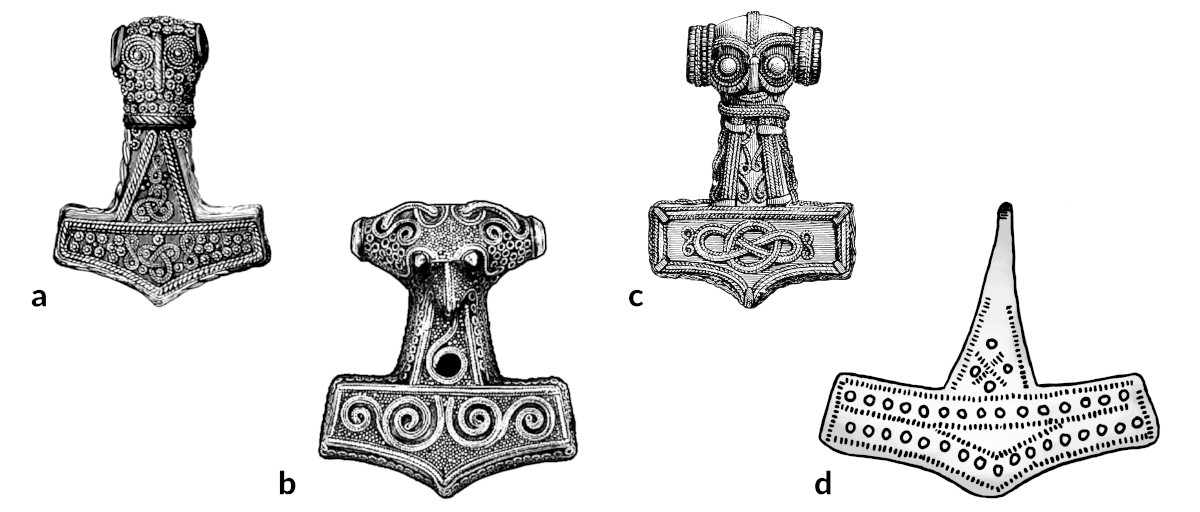
Many of the Thor’s hammer pendants on the market today are based on these four specimens. However, the variety of these amulets is considerably greater. They were produced in many different forms and from practically every possible material. There are Thor’s hammers made of iron, bronze, silver, gold, sheet metal, amber, lead and even sandstone, as a recently found Thor’s hammer on Iceland shows.2 Even the characteristic short handle of the hammer, as mentioned in Snorri’s Prose Edda3 and Saxo’s History of the Danes4, is not a universal feature.5 Moreover, the Thor’s hammer finds are not limited to Scandinavia alone. Their distribution area extends over a large geographical region from Ireland in the west to Moscow in the East. In this article we will therefore take a look at some finds outside Denmark and Sweden, the main distribution area of the Thor’s hammer pendants. More precisely, the focus will be on a small group of remarkable finds from the southern North Sea coastal region and its hinterland: the settlement area of the Old Saxons and Frisians.
The Age of Thor’s hammer pendants
It is no easy undertaking to get a good overview of the variety of shapes and the temporal and spatial distribution of the Thor’s hammer pendants. The reason for this is that there is still no extensive in-depth study on the approximately 150 specimens6 found to date. The last major work on the subject was carried out by Jörn Staecker, who dealt with the Thor’s hammers in a excursus in his dissertation on cross and crucifix pendants.7 Staecker establishes a first classification of forms and dates the majority of the pendants roughly to the 10th to 11th century. Unfortunately, his work is now almost 25 years old and limited to (Old) Denmark and Sweden. In the meantime, however, many exciting new finds have been made. An extensive revision of the material would therefore be urgently necessary.
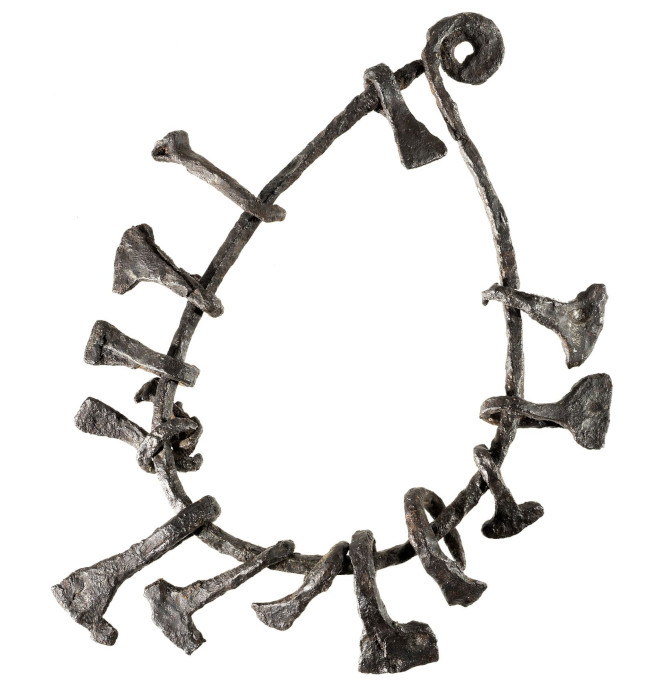
There is no doubt that most Thor’s hammer pendants were worn during the 10th and 11th centuries. They are therefore directly related to the Christianization of Scandinavia. However, the custom of wearing Thor’s hammers cannot have been solely a reaction to the spread of Christianity. This is indicated by some early specimens found in and around Birka (near Stockholm, Sweden). These so-called Thor’s hammer rings (see Fig. 2) already emerge in the 9th century and differ considerably from the usual Thor’s hammer pendants. Instead of a single pendant, they have many small miniature hammers and rings attached to a large iron ring. Since most of this Thor’s hammer rings come from cremation graves, it is difficult to say exactly how and where they were worn. However, there are sporadic finds from inhumation graves, which indicate the use as neck rings.8
Thor’s hammer finds from England
But Thor’s hammer pendants were not only found in Scandinavia. Other early specimens come from the Viking camps of Repton and Torksey, which were built between 872 and 874 during the presence of the “Great Heathen Army” in England.9 The Thor’s hammer of Repton (Fig. 3), for example, was found in the grave of a 40-year-old warrior who, according to his wounds, lost his life in battle. The Thor’s hammer was found together with two glass beads at the man’s neck.10 This exciting finding documents the Thor’s hammer custom already in the second half of the 9th century and also contradicts the common statement that these pendants were worn almost exclusively by women. This often repeated assertion is based on the observation of Danish grave finds. There, in fact, only women seem to have been buried with the Thor’s hammer. In Sweden, however, the gender ratio is quite balanced, which could indicate that it was perhaps just not customary in Denmark to bury deceased men with this kind of jewellery or amulets.11 It is a classical, methodological error to deduce the actual life reality of the buried from the objects found in their graves. This can, but does not necessarily have to be congruent.12
As far as the numerous “English” Thor’s hammers are concerned, the archaeological record clearly shows that these are Scandinavian products that came to the British Isles following the Viking invasions.
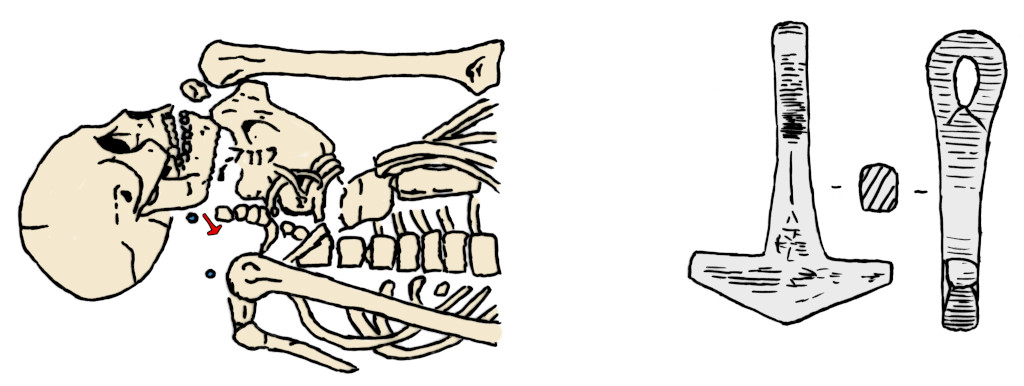
In addition, there are two remarkable burial finds from Guilton in England’s southeastern county of Kent, which are often interpreted as a very early versions of the Thor’s hammer. In two women’s graves excavated by Bryan Faussett in 1760, a number of small miniature weapons and tools were found in the hip area of the deceased. These pendants, probably worn on the belt, were also fitted with a total of three hammer-shaped objects (see Fig. 4).13 However, it is difficult to say whether these miniature hammers, dated to the 6th century, explicitly depict Thor’s hammers – and it is doubtful that they actually do.14 They are rare exceptional finds which, unlike the Thor’s hammer pendants, were worn on the belt together with other miniature weapons, such as spears. Furthermore, the chronological distance to the Viking era specimens is quite large. The templates of such miniature pendants come in any case from the already Christianized Merovingian Empire, which at that time wielded a very large cultural and political influence on the county of Kent.15 The function of such miniature weapon pendants, however, was certainly apotropaic, i.e. warding off misfortune and evil influence. Thus, a connection with Thor’s hammer as well as with the even older Roman Hercules club pendants cannot be ruled out completely.16
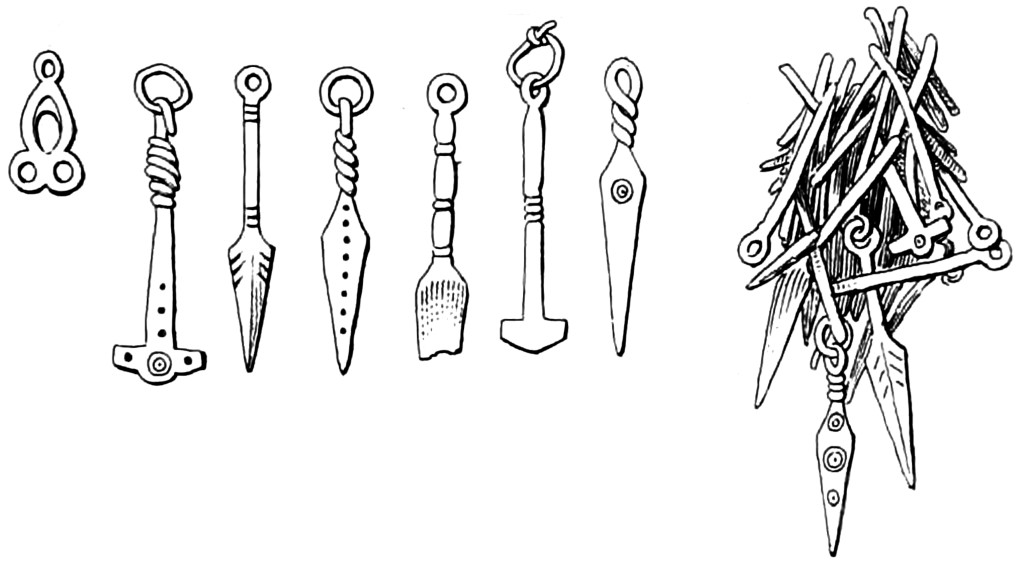
Thor’s hammer pendants from Northwestern Germany
From the area around Haithabu, the well-known early medieval trading town on the Schlei, numerous finds of Thor’s hammer pendants have been known for a long time (see Fig. 5).17 They can easily be linked to the numerous specimens found in Denmark. This is because the (southern) part of Schleswig, which today is belonging to Germany, was an integral part of the Danish dominion during the Viking Age and long afterwards, until the year 1864. Finds of Thor’s hammer pendants are therefore hardly surprising in this area and do not differ significantly from those from the other Scandinavian regions. But how do things look further south and west, in the areas of the Old Saxons and Frisians? Was the custom of wearing Thor’s hammers common among them as well?

It certainly appears to be! Though one can count the Thor’s hammer pendants found so far on Old Saxon and Frisian territory on one hand, they are however particularly interesting both because of their shape as well as their context and dating.
First there is the Thor’s hammer from Nebel, on the North Frisian island of Amrum, which was was discovered as early as 1882 near the large Bronze Age burial mound “Esenhugh”. During the excavations there, an urn with cremated human remains was recovered inside burial mound no. 35. Besides other grave goods indicating a female burial, the grave also contained the iron Thor’s hammer (Fig. 6) as well as some glass beads.18 Its strikingly long handle is very unusual and its age is also exciting: on account of the other objects found, the burial is dated to the late 8th or early 9th century.19 Thor’s hammers with equally long handles are rare, but not unparalleled. Corresponding Thor’s hammers were found on the site of the Aggersborg, Denmark’s largest Viking ring castle. However, these specimens are more than 200 years younger than the Thor’s hammer from Nebel!
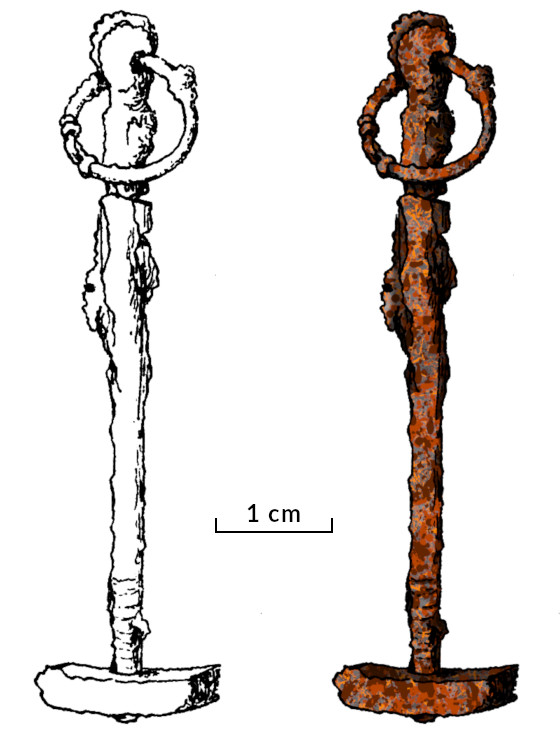
Further south, from the municipality of Kneitlingen (Landkreis Wolfenbüttel) comes another remarkable piece (Fig. 7). Its interpretation as a Thor’s hammer, however, is controversial. Unlike all the other pendants, which were attached upside down, the bronze hammer of Kneitlingen is suspended from the head and not from the end of the handle. Its shape and decoration are also quite unique so far. Unfortunately, this specimen is a stray find that has been handed down without the context necessary for dating and interpretation. Not least for that reason it remains extremely questionable whether the hammer of Kneitlingen really is a Thor’s hammer, as some authors suggested.20 Staecker, for example, does not consider such hammer pendants to be Thor’ s hammers because of their different suspension. Instead he dates comparable specimens, such as the hammer from Westerdeichstrich (Dithmarschen) to the late Middle Ages.21
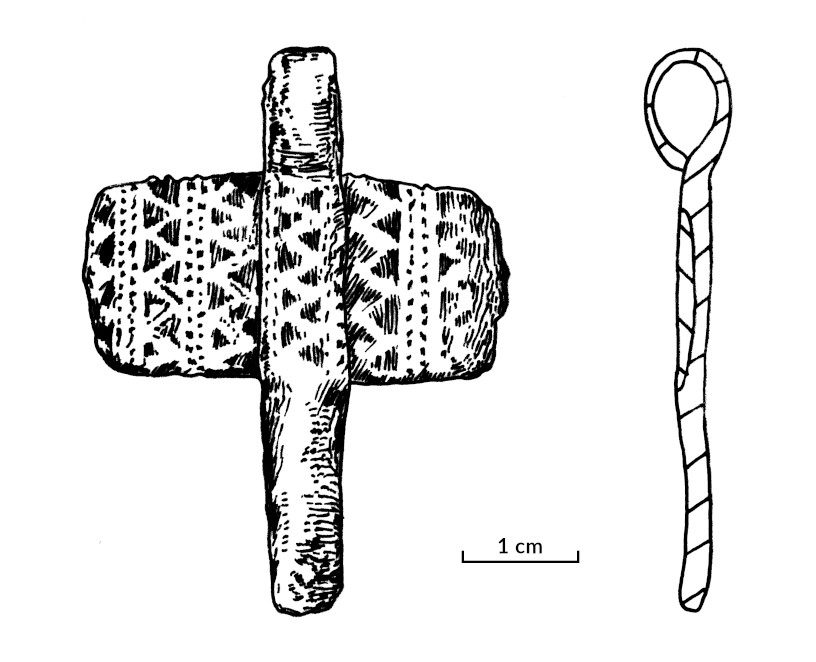
At the beginning of the new millennium, a new Thor’s hammer find from the Münsterland caused sensation. The Thor’s hammer pendant published for the first time in 2001 was found in a pit-house of the Old Saxon settlement of Warendorf close to the river Ems.22 The find consists of two iron Thor’s hammers attached together to a single ring (Fig. 8). The Warendorf pendant thus resembles a group of Thor’s hammers on small rings which were attached to wagon bodies and other kinds of wooden chests. Comparable specimens from Thumby-Bienebek or Ketting (both Schleswig) are however much larger than the Thor’s hammers from Warendorf, which are more similar in size to the well-known pendants worn around the neck.
But there is another remarkable characteristic of the Warendorf pendant: its old age. Originally even thought to date back as far as 700 AD, the find is now dated to the second half of the 8th century.23 The aforementioned finds from Thumby-Bienebek and Ketting are, however, at least 150 years younger.24 Thus the time interval between those finds is far too large to establish a direct connection without further ado. The Thor’s hammer pendant of Warendorf is therefore completely unique in terms of shape and chronology.
Not least because of this uniquity, it is today difficult to say with certainty in what way the Thor’s hammer pendant from Warendorf was used. While two of the accompanying finds in the pit-house support the idea of the Thor’s hammer being attached to some kind of wooden box, this does not mean, however, that it must necessarily have been a wagon body.25 The possibility of it being worn on a belt or even as a neck pendant cannot be ruled out entirely. Ultimately, only new discoveries of comparable specimens can bring more clarity into this matter.
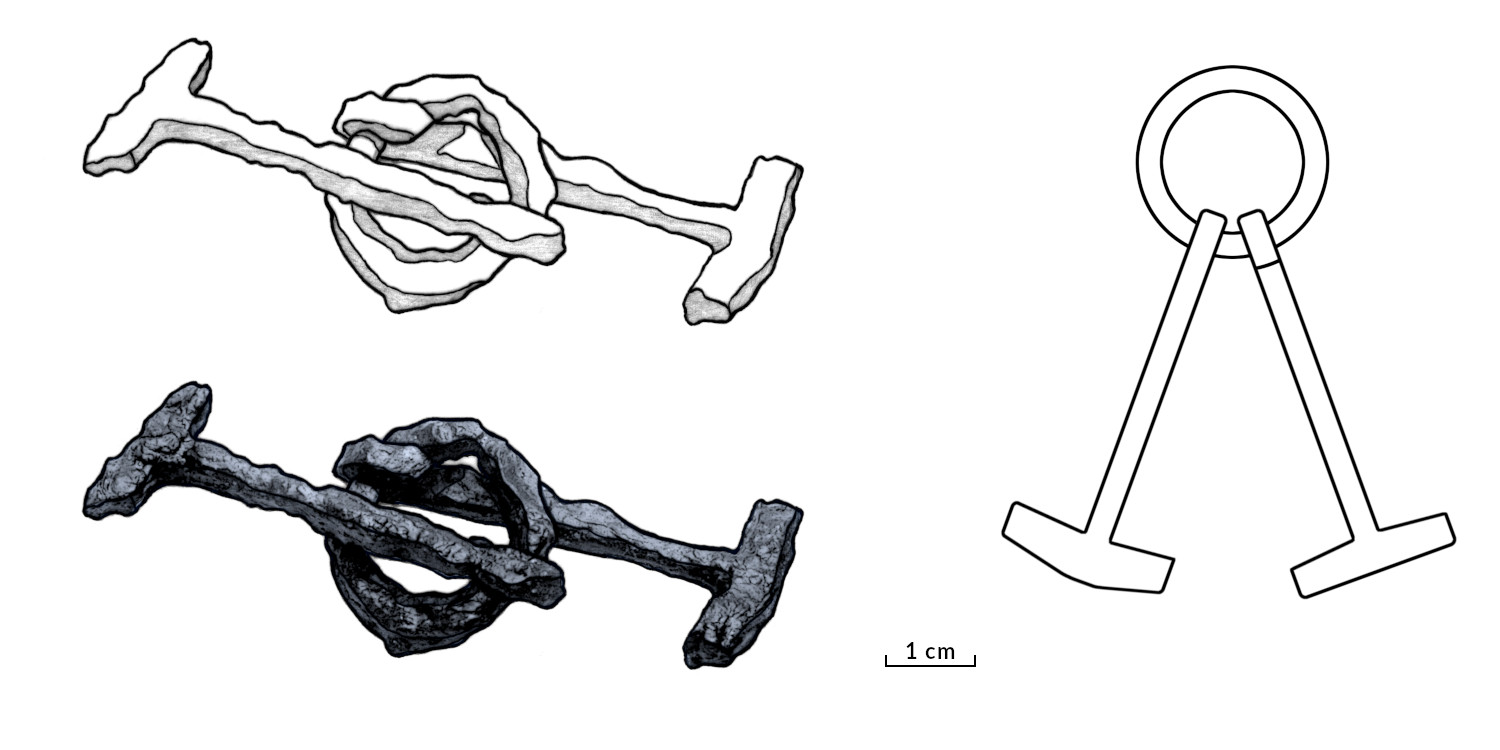
Finally, there is another remarkable Thor’s hammer find from Dithmarschen on the German North Sea coast, which today is almost completely forgotten. During the excavation of the Immenstedt burial site in 1880, a bronze Thor’s hammer (Fig. 9) was found strung along a chain of coloured pearls. It was located in the neck area of a female inhumation grave in tumulus 14 P. The extremely fragile find was carefully excavated along with the surrounding soil, but unfortunately it largely disintegrated into dust because it was touched too early during the conservation process. The fact that this extraordinary find was recorded at all is a great stroke of luck, because the responsible excavation team headed by Johanna Mestorf did groundbreaking work for their time. Thus the original form and size of the Thorshammer was drawn in advance and even the coloured pearls were pulled back onto a string in the correct order. Mestorf herself has explicitly guaranteed the correctness of this work.26 Under the excavation conditions customary at that time, the Thor’s hammer of Immenstedt would otherwise certainly have been destroyed during the excavation process without any chance of beeing preserved for posterity. Thanks to the diligence of the excavators, however, it has been documented together with its context in a way that is still verifiable today.
And this context is quite astonishing, because the burial is dated to the 8th or early 9th century27 and shows without any doubt that the Thor’s hammer was worn around the neck as a pendant. Thus, the Thor’s hammer of Immenstedt is nothing less than the oldest evidence for these pendants worn as a necklace ever found. At the same time, it is also the oldest Thor’s hammer with the “classical” short handle, which is typical for Denmark and Sweden; only that this specimen from Northern Germany is several generations older than comparable pieces from the north. Furthermore, there is no evidence that the deceased could have emigrated from Scandinavia to Immenstedt. On the contrary: the south-north orientation of the burial (with the head in the south and the feet in the north) clearly points to the Old Saxons, for whom this burial practice is virtually a defining part of their identity. The Thor’s hammer of Immenstedt is thus undoubtedly one of the most important key finds for this early period even if there are no other comparable finds with a similar dating so far.
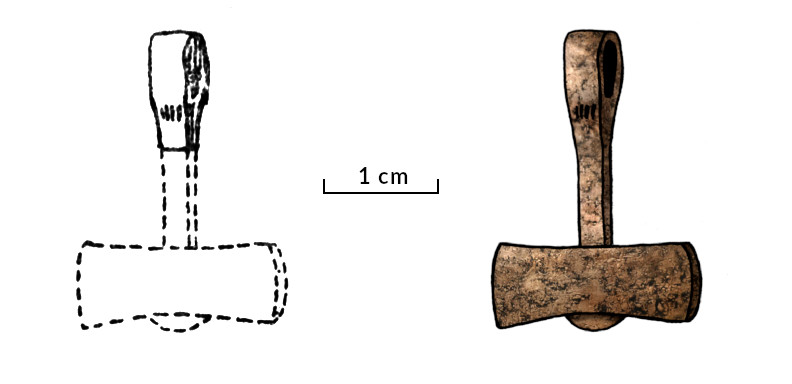
The three Thor’s hammers from Nebel, Warendorf and Immenstedt are extraordinary finds in many respects. They clearly prove that the Old Saxons and probably also the Frisians (if the women’s grave from Nebel is of Frisian origin) already knew and used these amulets; long before the custom of wearing a Thor’s hammer can be detected on a large scale in Scandinavia. In fact there is only one find from Scandinavia that is comparable in age: the Thor’s hammer ring of Valsgärde (Fig. 10).28 However, this Thor’s hammer ring from a burial mound near Gamla Uppsala has hardly any similarities with the Northwest German finds as well as the later “classical” Thor’s hammer pendants from Scandinavia. Rather it is the earliest known specimen of an own category called “Thor’s hammer rings” mainly found in central Sweden (compare Fig. 2).
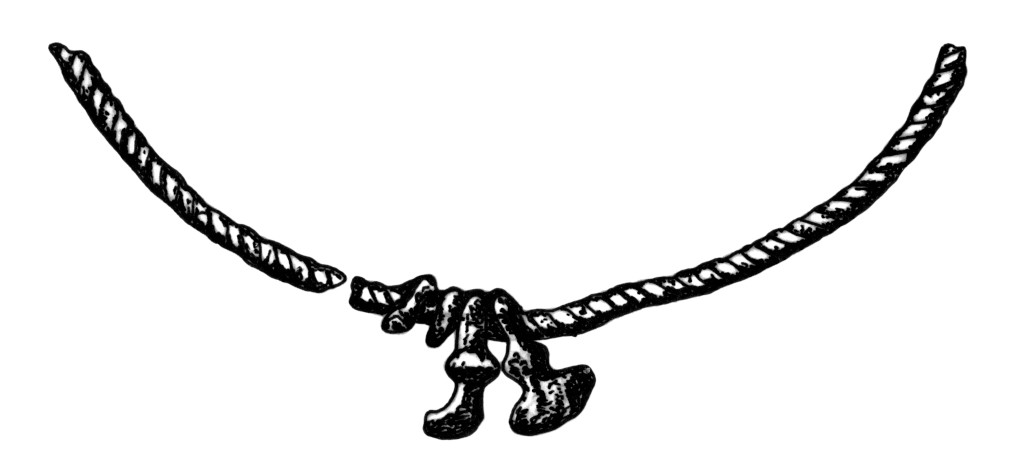
Dating back to the second half of the 8th to early 9th centuries, the three Northwest German finds originate from an extremely turbulent period: the violent conquest and conversion of the Old Saxons and Frisians by the Christian Frankish Empire. The Saxon Wars, raging from 772 to 804, gave the rest of heathen Europe a clear understanding of whar the cultural and religious conflict of the future would be like. It is noteworthy that these Thor’s hammers date from precisely the time when it was necessary to distinguish one’s own old traditions from the aggressively expanding Christendom. In Scandinavia, too, wearing Thor’s hammer pendants did not really come into fashion until the beginning of Christianization. Among scholars they are hence often understood as identification signs and counter-symbols to the Christian cross.29 This would also be conceivable for the Northwest German specimens.
So do these findings imply that the Thor’s hammer pendants were first worn by the Old Saxons and Frisians as a reaction to the violent Christianization and then, and a few generations later were also used in Scandinavia for similar reasons? Although this cannot be ruled out, so far there is not enough evidence to prove it sufficiently. The very early isolated finds from Northwest Germany indicate that we actually know very little about this early period. The fact that the majority of those very early Thor’s hammer pendants and rings were made of iron might also be responsible for this obscurity. Nowadays, after centuries of lying in the moist earth, such finds are mostly rusted beyond recognition. Moreover, heavily rusted iron objects were often ignored and thrown away during excavations up until the early 20th century and even afterwards. Only new excavations with a thorough examination of the iron finds (e.g. by radiological image techniques) can ultimately lead to new insights.
Literature
Biddle & Kjølbye-Biddle 1992
M. Biddle/B. Kjølbye-Biddle, Repton and the Vikings. Antiquity 66, 1992, 36–51.
Bulka 2008
K. Bulka, Die Grabungen von Warendorf-Neuwarendorf und Warendorf-Velsen. Ein kleinräumiges, mittelalterliches Siedlungsgefüge links und rechts der Ems (Diss., Münster 2008).
Faussett 1856
B. Faussett, Inventorium Sepulchrale. An Account of Some Antiquities dug up at Gilton, Kingston, Sibertswold, Bafriston, Beakesbourne, Chartham, and Crundale, in the County of Kent, from A.D. 1757 to A.D. 1773 (London 1856).
Grünewald 2001
Ch. Grünewald, Frühe Thorshammer-Anhänger aus Warendorf an der Ems. In: E. Pohl, Archäologisches Zellwerk. Beiträge zur Kulturgeschichte in Europa und Asien (Rhaden/Westfalen 2001) 417–423.
Hadley & Richards 2016
D. M. Hadley/J. D. Richards, The Winter Camp of the Viking Great Army, AD 872–3, Torksey, Lincolnshire. The Antiquaries Journal 96, 2016, 23–67.
https://doi.org/10.1017/S0003581516000718
Jarman et al. 2018
C. L. Jarman/M. Biddle/T. Higham/Ch. B. Ramsey, The Viking Great Army in England. New dates from the Repton charnel. Antiquity 92, 2018, 183–199.
https://doi.org/10.15184/aqy.2017.196
La Baume 1953
P. La Baume, Die Wikingerzeit auf den Nordfriesischen Inseln. Jahrb. Nordfries. Ver. Heimatkde. 29, 1952⁄53, 5–185.
Meaney 1981
A. L. Meaney, Anglo-Saxon amulets and curing stones. BAR British Series 96 (Oxford 1981).
Mestorf 1885
J. Mestorf, Vorgeschichtliche Alterthümer aus Schleswig-Holstein. Zum Gedächtnis des fünfzigjährigen Bestehens des Museum vaterländischer Alterthümer in Kiel (Hamburg 1885).
Mestorf 1888
J. Mestorf, Ausgrabungen bei Immenstedt (1879–80). Mittheilungen des Anthropologischen Vereins in Schleswig Holstein 1 (Kiel 1888).
Müller-Wille 1976
M. Müller-Wille, Das wikingerzeitliche Gräberfeld von Thumby-Bienebek (Kr. Rendsburg-Eckernförde). Teil I (Neumünster 1976).
Niquet 1966
F. Niquet, Archäologische Zeugnisse frühen Christentums aus dem südöstlichen Niedersachsen. In: H. W. Krumwiede (Ed.), Vorchristlich-christliche Frühgeschichte in Niedersachsen. Jahrb. Ges. Nieders. Kirchengesch. Beih. 64 (Blomberg 1966) 33–40.
Pestell 2013
T. Pestell, Imports or Immigrants? Reassessing Scandinavian Metalwork in Late Anglo-Saxon East Anglia. In: D. R. Bates/R. Liddiard (Eds.), East Anglia and its North Sea World in the Middle Ages (Woodbridge 2013) 230–255.
Schwarz-Mackensen
G. Schwarz-Mackensen, Thorshämmer aus Haithabu - Zur Deutung wikingerzeitlicher Symbole. In: K. Schietzel (Hrsg.), Das archäologische Fundmaterial 3 der Ausgrabung (Neumünster 1978) 85–93.
Soulat 2013
J. Soulat, Study of Merovingian-type grave-goods in Kent. A first approach. In: B. Ludowici (Ed.), Individual and Individuality? Approaches towards an Archaeology of Personhood in the First Millennium AD. Neue Studien zur Sachsenforschung 4 (Hannover 2013) 205–215.
Staecker 1999
J. Staecker, Rex regum et dominus dominorum. Die wikingerzeitlichen Kreuz- und Kruzifixanhänger als Ausdruck der Mission in Altdänemark und Schweden. Lund Studies in Medieval Archaeology 23 (Stockholm 1999).
Stein 1967
F. Stein, Adelsgräber des achten Jahrhunderts in Deutschland. German. Denkm. Völkerwanderungszeit. Ser. A,9 (Berlin 1967).
Ström 1984
K. Ström, Thorshammerringe und andere Gegenstände des heidnischen Kults. In: G. Arwidsson (Hrsg.), Birka. II:1. Systematische Analysen der Gräberfunde (Stockholm 1984) 127–140.
Werner 1964
J. Werner, Herkuleskeule und Donar-Amulett. Jahrb. RGZM 11, 1964, 176–197.
- Cf. Staecker 1999, 535–538 (No. 58, 61 and 68). ^
- Article in Iceland Magazine from Oct. 12th 2018. ^
- Skáldskaparmál 33. ^
- Gesta Danorum III, Paragraph 11. ^
- Older literary sources (both Snorris and Saxo’s works date from the 13th century) give no direct indication of a short hammer handle. The Thor’s hammer depictions on the Swedish rune stones of Altuna, Norra Åby and Stenkvista also show no shortened handle. ^
- The Thor’s hammer rings, which originate mainly from Birka and its surroundings, are not counted here. ^
- Staecker’s (1999) dissertation dates from 1995, but was not published until four years later. ^
- Cf. Ström 1984, 130–135. ^
- See: Hadley & Richards 2016. – About other Thor’s hammer pendants from the Danelag see: Pestell 2013, 238–242. ^
- Biddle & Kjølbye-Biddle 1992. – Recent publication on the dating: Jarman et al. 2018. ^
- Cf. Staecker 1999, 218. ^
- A famous example for this is the burial practice of the early Goths: They did not bury their deceased with weaponry, apparently because there was a taboo about this. Thus, hardly anyone would claim that the Goths did not have any weapons at all. As it is well-known from history, the exact opposite is the case: the Goths were undoubtedly among the most warlike and militarily successful Germanic tribes. ^
- Faussett 1856, 9–13. – Although Faussett’s excavation methods were extremely advanced for his time, they did not meet modern standards. Nevertheless the finds can be traced in their context by the excellent documentation of Faussett, even if today many of the old finds are unfortunately lost. ^
- See: Werner 1964, 182; Meaney 1981, 148–162. ^
- Cf. Soulat 2013. ^
- Cf. Werner 1964. ^
- Cf. Schwarz-Mackensen 1978. ^
- La Baume 1953, 79–80; Staecker 1999, 524 Nr. 20. ^
- To the end of the 8th century: La Baume 1953, 79; Later dating: Müller-Wille 1976, 58 No. 20. ^
- See: Niquet 1966, 39. ^
- Staecker 1999, 219. ^
- Grünewald 2001. ^
- See: Bulka 2008, 123. ^
- Cf. Staecker 1999, 132–134. ^
- Cf. Bulka 2008, 122. ^
- Mestorf 1885, 33–34; 1888, 12; 17–18. ^
- Stein 1967, 192. Müller-Wille 1976, 38 Ref. 128. ^
- Cf. Ström 1984, 135. ^
- See: Staecker 1999, 236. ^